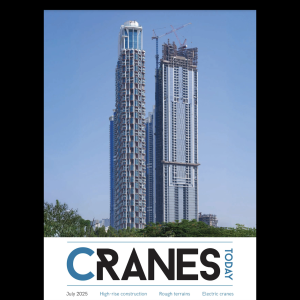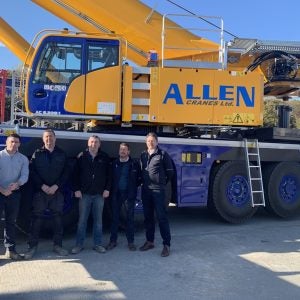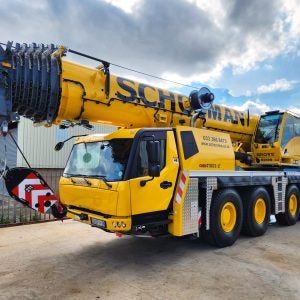About 30 years ago top-slewing saddle jib cranes were the norm in Europe. They accounted for 90% of 100tm construction cranes and nearly all climbing cranes. Elsewhere in the world, the luffing jib design was preferred and manufacturers produced tower cranes which had their roots in the portal mounted crawler crane upper.
Then, in the mid-1980s, German manufacturers Peiner and Liebherr developed top-slewing luffing jib cranes. Their SN and HC-L series led the way for nearly every other European manufacturer to design luffing jib cranes in the 1990s. The rationale was not to meet a European demand but to strengthen their position in booming export markets.
Luffing jibs are reckoned to have key advantages over saddle jibs on sites where space for slewing is restricted. But the Europeans had been happily optimising the saddle jib concept for space restricted sites. A special demand had been created by nuclear power station building programmes in France during the middle of the 1970s.
Today, it seems, luffers are the design of choice for space-restricted sites the world over. But luffing cranes have their shortcomings. So could there be a revival of special saddle jib crane designs to master the growing space problems on city sites?
Modified standard cranes with reduced jibs
In some cases it will be enough just to reduce the jib of a standard crane to cope with restricted site conditions. This would be a low cost option and would have several benefits over a luffing jib crane, namely:
Fast horizontal load movements are possible when changing the lifting radius. A trolley can move three or four times more quickly, mainly due to the required multiple reeving of the luffing rope.
In general, saddle jib cranes cause less corner force than comparable luffers. This is the result of the moment movement which is extended by the luffing jib design due to the moving boom and its centre of gravity.
At minimum radius a saddle jib crane has no system-incorporated additional length of the hookline. Hence placing the load will be more exact.
Under certain circumstances the lower profile of saddle jib cranes is less sensitive for high wind speeds than that of a crane with a luffed jib.
Three-dimensional movements present a greater accident risk when cranes have to work in close proximity. Coordination is not as easy as with multiple saddle jib cranes kept on different heights to avoid collision.
Saddle jib designs are usually cheaper because luffers have a second large winch. Saddle jibs generally consume less power, are easier and cheaper to erect, and specialised versions can be configured from standard versions by shortening counterjibs.
On the other hand, especially on narrow construction sites, luffers do have some distinct advantages.
Normally, the boom of saddle jib cranes cannot be raised, so no extra capacity or extra height is gained at minimum radius. The fixed jib height is the most critical disadvantage when the crane has to fit into a cramped site.
Restricted site conditions and the well-established air rights licensing system, which seem to allow unlimited fees to be demanded when cranes oversail neighbouring properties, have led to the intensive use of luffers in the city of London in the UK. While some rental companies predict that in three or four years time virtually all jobs performed in London will need luffing jib cranes, others are quick to point out that, because of their clear benefits, saddle jib designs will continue to be used wherever it is at all possible. Therefore, with only the minimum of cooperation between neighbours, saddle jib cranes with specially reduced jibs will have a market.
The UK distributor for Wolff, Hewden Tower Cranes, provides the 100 EC, 5015 FL, 135 EC and 200 EC with standard jib lengths reduced by up to 10m, often enough to prevent oversailing. For example, the 200 EC (WK 192 SL) can be supplied with a 20m short jib instead of the common 30m minimum jib length. The counterjib remains the standard 17.52m, and only wind-pressure plates in the jib – to help weathervane – are to be added to convert the crane into a niche specialist.
During the massive French nuclear power development programme in the 1970s and 1980s Potain and Richier-BPR had to develop cranes that complied with laws which prohibited oversailing. The result was saddle jib models with shortened counterjibs, using as many components as possible from the standard crane range. In fact, for all models the transformation into cranes with standard counterjibs, for maximum jib length, was kept in mind. The range included models from 140tm to 320tm with 7m to 18m counterjib radii. With these cranes every part of a large site was covered by more than one crane. In addition, the zones of interference between counterjibs and hoisting cables were minimised. Several of these cranes later found a ready market at other sites of high crane densities, like city and dam construction sites.
Pendant-free jib designs like the original Linden 8000 series or those with extremely short pendants like the former Richier-BPR cranes provide great flexibility in the jibs and counterjibs. For example, when reducing the jib of the Linden 8452 from 64m to 30m, the tail radius can be diminished at the same time from 19m to 10.6m. In the same capacity class, cranes using pendants have to be equipped with specially designed counterjibs when a tail radius of less than 11m is required.
Special versions with a 7m counter radius usually need intensive modifications to the standard crane, for three reasons:
Because of the ratio of the counterjib to the jib, normally 1 to 3, other ratios may lead to a sharper decline in capacity at maximum radius, even when additional ballast is used.
Higher corner forces may require the application of stronger tower sections or reduced free-standing heights.
To aid proper spooling, the angle at which the rope leads onto the drum (the fleet angle) must be kept in controlled limits. When using short counterjibs the required distance between lead sheave and drum is not available. Therefore Liebherr installed a mechanical rope reeving device next to the drum on the 7m counterjib of the 132 EC-H for the Hibernia offshore construction project in Canada. On the Wolff WK 192 SL with 6.7m counterjib radius, engaged during an alpine telecommunication tower project on the Säntis in Switzerland, the lead sheave was simply raised on a 2.5m tower head extension for the same reason.
Master of space: saddle jib cranes with retractable jib
First introduced by Potain to cope with narrow nuclear power station sites, cranes with retractable jibs have a small space requirement as jib length can be halved to operate on obstructed sites. Jib retraction, even with load on the hook, allows these cranes to pass around obstacles without having to overfly them. This concept avoids great heights and allows for lower towers made up of smaller mast sections which are not only less expensive to set up but also less sensitive to the high winds which so often afflict the coastal sites of power stations. Since the middle of the 1970s, 54 of these special cranes were manufactured from 100tm capacity to 280tm. The last one left the factory in 1986 and was engaged on a cramped city site in Stockholm, Sweden. In this case, two of these cranes worked under a conventional saddle jib “umbrella” crane.
When trolleying out, the trolley is locked to the sliding jib section. A similar working principle is used by the Japanese tower crane manufacturer Ogawa. The OTH-150 NS provides a 50m jib. Even when fully retracted, the minimum jib length remains significantly more than half of the maximum jib length, due to the location of the trolley winch. Potain’s sliding jib is fully retractable to the jib foot. Maximum capacity of the OTH-150 NS is 6t.
In contrast Liebherr uses a rope-operated movable outer jib, hanging under the fixed jib. On the outer jib the trolley can be run independently. The Liebherr HC-T series is made up of a 100tm model and a 300tm model. Liebherr claims that the moving counterweight balances the dead moment of the moving outer jib, creating low corner forces. Introduced in 1989, the only 300tm crane to have been built has been engaged in power construction projects, firstly in the UK and now in China. The two 100tm models built since 1991 have been used on constricted city sites in Sweden and Germany. At the moment one 100 HC-T is working in Düsseldorf, Germany, working under a 280 EC-H umbrella crane at the edge of a complex museum building site. Thanks to an adapter frame, mounted under the slewing platform, more conventional 256 HC tower sections can be used in Germany instead of the original 170 HC tower sections. The crane is on rent from TDK Turmdrehkran Vertrieb Service, which sees more opportunities in the near future for this specialist niche crane outside the industrial construction sector. Even though their number will be limited as well as the capacity – in most cases not more than 8t – the cranes may be the right answer for city sites where the cranes are working side by side with conventional saddle jib cranes.
Hybrid luffers and saddle jib cranes
The EMA lifting device of Potain, which was also originally designed for nuclear power station construction, provides extraordinary features which have never been seen since. The climbing crane is equipped with a counterjib of only 4.8m and a retractable saddle jib (30m to 16m radius). To overcome space problems, the retractable jib can be lifted by sliding down the upper part of the tower. Thereafter the minimum radius is only 5m, while the overall height of the crane is not extended as is the case with typical luffing jib cranes. One of these units was re-used on a cramped city site in London by contractor Sir Robert McAlpine in 1990.
In a way, articulated jib cranes like those built by Elba-Kaiser, Liebherr and Peiner are also hybrids of saddle jib and luffing jib cranes. Some are specially modified to allow application in extremely tight site conditions. In 1983 two Elba-Kaiser cranes working closely together were rigged only with the basic boom section to build a 140m-high concrete pylon on a bridge project at Twimberg, Austria. While the tail radius remained the standard 5.8m, the jib was reduced to 12.5m.
In New York a Pecco (Peiner) SKK 140 articulated jib crane was equipped with the basic boom section and only 6m luffing boom instead of the 21m standard one, allowing only minimum trolley movement in the raised position. Therefore the application is similar to a conventional luffing jib crane with the benefit of a design incorporating horizontal load movement.
IHI of Japan introduced the JCC 200U luffing jib crane in 1977, with 9.7m counter radius and up to 60m jib. As a real 200tm multi-purpose crane, it is still also offered as a hammerhead version with 35m saddle jib under the name 60D-35H, mounted either on crawlers or rails. In contrast to normal saddle jib, cranes it can raise the jib to lift mast sections into the turntable frame while climbing in the same manner as the luffing jib version. First tried at the Kuroda Dam site, the hammerhead crane turned out to be suitable for concrete placing at high-frequency cycles thanks to the saddle jib design. A similar design of a luffable saddle jib crane could also be found in the range of the no longer produced Kodiak Cranes in the USA.
Chinese manufacturer Jianglu developed the QTD 160 in 1997, a 240tm self-climbing crane combining a luffing jib with a travelling trolley. Like the more familiar BKT (now Potain) and Liebherr 500 HC-L luffing jib crane designs, this crane is equipped with ballast swingers.
Project orientated modification of saddle jib designs
In order to oversail when weathervaning, one of the Liebherr 224EC-H pylon cranes which was engaged in the Øresund Link bridge building project was equipped with an hydraulically 70O luffable, 12.88m jib end section.
At large cooling tower building sites, saddle jib cranes with jib-self-dismantling devices are installed so that they can climb down inside the finished cooling tower. Examples are Linden 8000 and Liebherr HC-EC-H series cranes. Additionally, for the Tin Kau bridge project in Hong Kong, Liebherr developed a 280 EC-II crane with luffable counterjib which enables the crane to self-climb down between the bridge cables and the pylon. Boiler house construction can present the same problem of climbing down the rigging equipment. Before large luffers led the way, Peiner designed a special MK 1800. The 140m free-standing giant with only 18m tail radius and a maximum capacity of 80t was to be rigged with a 28m foldable jib suitable for climbing down inside a 30mx30m boiler house frame.
While this crane never left the drawing board, Krøll has saddle jib cranes with extremely short counterjibs and a maximum capacity of 50t, designed for the shipbuilding industry, like the K-1600 for Kockums AB of Sweden.
The luffing jib development – the end of specially designed saddle jib cranes?
Although top-slewing luffers have become increasingly popular on cramped sites recently, it is still worth considering special saddle jib cranes in cases where conventional saddle jib cranes are also engaged on the same site.
Even on isolated tricky sites, saddle jibs are sometimes the only choice. The Säntis telecommunication tower building project in Switzerland was 250m above sea level; only a saddle jib crane could offer the necessary wind resistance, trolley movement to clear the ice from the jib, and scrapers on all the sheaves.






